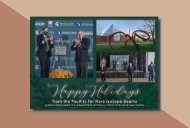202 FRIB Graduate Brochure
You also want an ePaper? Increase the reach of your titles
YUMPU automatically turns print PDFs into web optimized ePapers that Google loves.
Christopher Wrede<br />
Professor of Physics<br />
Keywords: Nuclear Astrophysics, Thermonuclear Reaction Rates, Fundamental<br />
Symmetries, Beta Decay<br />
Experimental Nuclear Physics<br />
About<br />
• MSc, Physics, Simon Fraser University, 2003<br />
• MS, M. Phil., Physics, Yale University, 2006<br />
• PhD, Physics, Yale University, 2008<br />
• Joined the laboratory in August 2011<br />
• wrede@frib.msu.edu<br />
Research<br />
How Students can Contribute as Part<br />
of my Research Team<br />
Students in our group have opportunities to propose,<br />
prepare, execute, analyze, and interpret nuclear-physics<br />
experiments at <strong>FRIB</strong> and other laboratories, to publish<br />
the results in leading scientific journals, and to present<br />
the results at national and international conferences. Our<br />
alumni have advanced to positions in national laboratories,<br />
academic institutions, and industry.<br />
Our research focuses on studying nuclei experimentally<br />
to probe fundamental questions about our Universe.<br />
For example, we measure nuclear reactions, decays, and<br />
masses in the laboratory to learn about the reactions<br />
that power exploding stars or affect their synthesis of<br />
chemical elements. In the near future, our program at<br />
<strong>FRIB</strong> will be focused on measuring the beta and electroncapture<br />
decays of proton-rich nuclides using the GADGET<br />
and PXCT detection systems. With these experiments, we<br />
hope to constrain the nuclear-structure details that are<br />
most influential on photodisintegration in supernovae<br />
and the explosive burning of hydrogen and helium on the<br />
surfaces of accreting compact stars such as white dwarfs<br />
and neutron stars. Similar experiments can allow us to<br />
test hypotheses that could explain the origins of dark<br />
matter in the universe or to better constrain the effects<br />
of isospin-symmetry breaking in nuclei on tests of the<br />
unitarity of the Cabibbo-Kobayashi-Maskawa matrix, a<br />
cornerstone of the Standard Model.<br />
Biography<br />
I was born in Vancouver, Canada, to Finnish parents,<br />
and began my research career in experimental nuclear<br />
astrophysics at Canada’s TRIUMF laboratory. In 2008,<br />
I obtained a PhD in Physics from Yale University based<br />
on work at the Wright Nuclear Structure Laboratory<br />
in the same research field. From there, I moved to<br />
a postdoctoral Research Associate position at the<br />
University of Washington’s Center for Experimental<br />
Nuclear Physics and Astrophysics. Since 2011, I have been<br />
leading a research group at NSCL and <strong>FRIB</strong> with a primary<br />
interest in nuclear astrophysics and secondary interests in<br />
fundamental symmetries and nuclear structure.<br />
The Gaseous Detector with Germanium Tagging<br />
(GADGET) prior to an <strong>FRIB</strong> experiment to determine the<br />
isotopic ratios expected in microscopic grains of stardust.<br />
Selected Publications<br />
Low-energy<br />
23<br />
Al B-delayed proton decay and<br />
22<br />
Na<br />
destruction in novae, M. Friedman et al., Phys. Rev. C 101,<br />
052802(R) (<strong>202</strong>0)<br />
GADGET: a Gaseous Detector with Germanium Tagging, M.<br />
Friedman et al., Nucl. Instrum Methods Phys. Res., Sect. A<br />
940, 93 (2019)<br />
Doppler Broadening in 20 Mg (B, p, y) 19 Ne Decay, B. E.<br />
Glassman, D. Perez-Loureiro, C. Wrede et al., Phys. Rev. C<br />
99, 065801 (2019)<br />
80<br />
<strong>202</strong>2_<strong>FRIB</strong>_<strong>Graduate</strong>_<strong>Brochure</strong>v4.indd 80<br />
10/29/<strong>202</strong>1 3:33:58 PM






